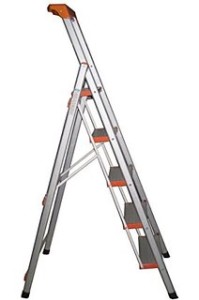
You may have wondered why aluminium ladders are regarded as superior to other alternatives such as wood.
Firstly, let’s think about how ladders are used. Ladders are essentially portable stairs, which a person may alight to reach objects at a height that they could not achieve unaided. Each step provides more height, so a person may climb to anything from approximately thirty centimetres to over one metre. This makes ladders ideal for reaching light bulbs and smoke alarms, and to assist with indoor decoration. It is desirable that the ladder can be moved; if access to a height was required on a regular basis, a more permanent solution such as stairs should be in place.
The ladder needs to fulfil two needs: it is required to support the weight of a person, and it also must be portable. This means that metals such as steel, which is quite dense and therefore heavy for an object the size of a ladder, are not suitable to be used in making a ladder. Aluminium is chosen as a material because it strikes a balance between these two needs. As a lightweight metal, it can be picked up and moved with relative ease; the main problem is actually how cumbersome the ladder is rather than how heavy. This is because aluminium is not dense compared to other metals, that is, there is more empty space between each particle. Despite being fairly light, aluminium is also quite strong. It is used thinly to make aluminium cans which can be easily deformed, but when a thick piece of aluminium is used, it becomes difficult to deform and break the metal. Aluminium is often used in combination with other metals to ensure a strong structure that remains at a small mass.
It is more than mere custom, ladders are made from aluminium because it provides strength while being lightweight enough for portability.